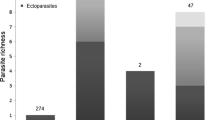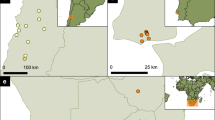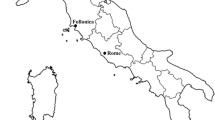Abstract
Damage caused by introduced species results from the high population densities and large body sizes that they attain in their new location1,2,3,4. Escape from the effects of natural enemies is a frequent explanation given for the success of introduced species5,6. Because some parasites can reduce host density7,8,9,10,11,12,13 and decrease body size14, an invader that leaves parasites behind and encounters few new parasites can experience a demographic release and become a pest4,15. To test whether introduced species are less parasitized, we have compared the parasites of exotic species in their native and introduced ranges, using 26 host species of molluscs, crustaceans, fishes, birds, mammals, amphibians and reptiles. Here we report that the number of parasite species found in native populations is twice that found in exotic populations. In addition, introduced populations are less heavily parasitized (in terms of percentage infected) than are native populations. Reduced parasitization of introduced species has several causes, including reduced probability of the introduction of parasites with exotic species (or early extinction after host establishment), absence of other required hosts in the new location, and the host-specific limitations of native parasites adapting to new hosts.


Similar content being viewed by others
References
Vitousek, P. M. Biological invasions and ecosystem processes: Towards an integration of population biology and ecosystem studies. Oikos 57, 7–13 (1990)
Wilcove, D. S., Rothstein, D., Dubow, J., Phillips, A. & Losos, E. Quantifying threats to imperiled species in the United States. Bioscience 48, 607–615 (1998)
Ruiz, G. M., Fofonoff, P., Hines, A. H. & Grosholz, E. D. Non-indigenous species as stressors in estuarine and marine communities: Assessing invasion impacts and interactions. Limnol. Oceanogr. 44, 950–972 (1999)
Torchin, M. E., Lafferty, K. D. & Kuris, A. M. Parasites and marine invasions. Parasitology 124, S137–S151 (2002)
Keane, R. M. & Crawley, M. J. Exotic plant invasions and the enemy release hypothesis. Trends Ecol. Evol. 17, 164–170 (2002)
Shea, K. & Chesson, P. Community ecology theory as a framework for biological invasions. Trends Ecol. Evol. 17, 170–176 (2002)
Crofton, H. D. A model of host–parasite relationships. Parasitology 63, 343–364 (1971)
Anderson, R. M. & May, R. M. Regulation and stability of host–parasite population interactions I. Regulatory processes. J. Anim. Ecol. 47, 219–247 (1978)
May, R. M. & Anderson, R. M. Regulation and stability of host–parasite population interactions II. Destabilizing processes. J. Anim. Ecol. 47, 249–267 (1978)
Scott, M. E. Regulation of mouse colony abundance by Heligmosomoides polygyrus (Nematoda). Parasitology 95, 111–129 (1987)
Gulland, F. M. D. The role of nematode parasites in Soay sheep Ovis aries L. mortality during a population crash. Parasitology 105, 493–503 (1992)
Kuris, A. M. & Lafferty, K. D. Modeling crustacean fisheries: Effects of parasites on management strategies. Can. J. Fish. Aquat. Sci. 49, 327–336 (1992)
Hudson, P. J., Dobson, A. P. & Newborn, D. Prevention of population cycles by parasite removal. Science 282, 2256–2258 (1998)
Torchin, M. E., Lafferty, K. D. & Kuris, A. M. Release from parasites as natural enemies: Increased performance of a globally introduced marine crab. Biol. Invas. 3, 333–345 (2001)
Dobson, A. P. & May, R. M. in Ecology of Biological Invasions of North America and Hawaii (eds Mooney, H. A. & Drake, J. A.) 58–76 (Springer, New York, 1986)
Shimura, S. & Ito, J. Two new species of marine cercariae from the Japanese intertidal gastropod Batillaria cumingii (Crosse). Jpn. J. Parasitol. 29, 369–375 (1980)
Rybakov, A. V. & Lukomskaya, O. G. On the life cycle of Acanthoparyphium macracanthum sp.n. (Trematoda, Echinostomatidae). 22, 224–229 (1988)
Harada, M. & Suguri, S. Surveys on cercariae in brackish water snails in Kagawa Prefecture, Shikoku, Japan. Jpn. J. Parasitol. 38, 388–391 (1989)
Chapman, F. M. Handbook of Birds from Eastern North America (Dover, New York, 1966)
Hair, J. D. & Forrester, D. J. The helminth parasites of the starling (Sturnus vulgaris L.): A checklist and analysis. Am. Midl. Nat. 83, 555–564 (1970)
Mitchell, C. E. & Power, A. G. Release of invasive plants from fungal and viral pathogens. Nature 421, 625–627 (2003)
Gregory, R. D. & Blackburn, T. M. Parasite prevalence and host sample size. Parasitol. Today 7, 316–318 (1991)
Acknowledgements
This work was conducted as part of the Diseases and Conservation Biology Working Group supported by the National Center for Ecological Analysis and Synthesis, a centre funded by the National Science Foundation (NSF), the University of California, and the Santa Barbara campus. We thank S. Altizer, S. Gaines, P. Hudson, H. McCallum, A. W. Miller, C. Mitchell and A. Power for discussion and comments; A. Dove and G. Ruiz for providing data; and L. Mababa for data collection. This research was supported by NSF through the NIH/NSF Ecology of Infectious Disease Program, and by the National Sea Grant College Program, National Oceanic and Atmospheric Administration (NOAA), US Department of Commerce through the California Sea Grant College System, and in part by the California State Resources Agency. The views expressed herein are those of the authors and do not necessarily reflect the views of NOAA or any of its subagencies. The US Government is authorized to reproduce and distribute for governmental purposes.
Author information
Authors and Affiliations
Corresponding author
Ethics declarations
Competing interests
The authors declare that they have no competing financial interests.
Supplementary information
41586_2003_BFnature01346_MOESM1_ESM.doc
Examples of parasites and introduced species and Supplementary Table I: Parasite data collection for 26 host species (DOC 101 kb)
Rights and permissions
About this article
Cite this article
Torchin, M., Lafferty, K., Dobson, A. et al. Introduced species and their missing parasites. Nature 421, 628–630 (2003). https://doi.org/10.1038/nature01346
Received:
Accepted:
Issue Date:
DOI: https://doi.org/10.1038/nature01346
- Springer Nature Limited
This article is cited by
-
Parasite and genetic diversity of big-scale sand smelt (Atherina boyeri Risso, 1810) populations in their natural and expansion ranges in Ukraine
Parasitology Research (2024)
-
Enemy of the invader: impact of the native ectoparasite Philornis spp. on an invasive bird species, the European starling (Sturnus vulgaris)
Biological Invasions (2024)
-
Mutualism at the leading edge: insights into the eco-evolutionary dynamics of host-symbiont communities during range expansion
Journal of Mathematical Biology (2024)
-
Spatially limited pathogen pollution in an invasive tick and host system
Biological Invasions (2024)
-
Comparative Analysis of Parasite Load on Recently Established Invasive Pumpkinseed Lepomis gibbosus (Actinopterygii: Centrarchidae) in Europe
Acta Parasitologica (2024)





